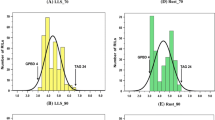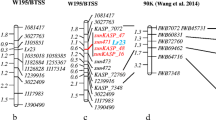Abstract
Recombinant inbred lines (RILs) from four populations involving cultivated varieties, and backcross lines from three populations involving cultivated varieties and synthetic tetraploids (developed from wild diploids) were employed for validating late leaf spot (LLS) and rust resistance-linked markers and identifying superior genotypes in peanut. GM2009, GM2301, GM2079, GM1536, GM1954 and IPAHM103 markers showed significant association with rust resistance. They were successfully validated in a new RIL (TG 19 × GPBD 4) and two backcross (DH 86 × ISATGR 278-18 and DH 86 × ISATGR 5) populations. GM1954, GM1009 and GM1573 markers showed significant association with LLS resistance. TAG 19 × GPBD 4 and ICGS 76 × ISATGR 278-18 populations showed strong co-segregation of LLS-linked markers with the phenotype. From these genetic resources, six superior genotypes were identified. RIL 78-1 was resistant to LLS and rust, and recorded 30 % more pod yield than GPBD 4 (control). It also had higher kernel yield and oil yield along with higher oleate and linoleate content over GPBD 4. These genetic and genomic resources could be useful in breeding for LLS and rust resistance in peanut.


Similar content being viewed by others
References
Bhat RS, Sujay V, Mukri G, Khedikar YP, Sarvamangala C, Yeri SB, Jadhav SS, Pujer SB, Narasimhulu R, Varshakumari, Azharudheen TPM, Varshney RK, Nadaf HL, Gowda MVC (2012) Utility of peanut mapping populations developed at UAS Dharwad, India VI International Conference on Legume Genetics and Genomics (ICLGG), Hyderabad Marriott Hotel & Convention Centre Hyderabad, India
Bromfield K, Bailey W (1972) Inheritance of resistance to Puccinia arachidis in peanut. Phytopathology 62:748
Cuc LM, Mace ES, Crouch JH, Quang VD, Long TD, Varshney RK (2008) Isolation and characterization of novel microsatellite markers and their application for diversity assessment in cultivated groundnut (Arachis hypogaea). BMC Plant Biol 8:55
Excoffier L, Laval G, Schneider S (2005) Arlequin ver 3.0: An integrated software package for population genetics data analysis. Evol Bioinform Online 1:47–50
Gowda MVC, Motagi BN, Naidu GK, Diddimani SB, Sheshagiri R (2002) GPBD 4: a spanish bunch groundnut genotype resistant to rust and late leaf spot. Int Arachis Newslet 22:29–32
IBPGR/ICRISAT (1992) Descriptors for groundnut, International Board of Plant Genetic Resources and International Crops Research Institute For the Semi-Arid Tropics, Rome, Italy and Patancheru, Andhra Pradesh, India
Khedikar Y, Gowda MVC, Sarvamangala C, Patgar K, Upadhyaya H, Varshney R (2010) A QTL study on late leaf spot and rust revealed one major QTL for molecular breeding for rust resistance in groundnut (Arachis hypogaea L.). Theor Appl Genet 121:971–984
Kumari V, Gowda MVC, Tasiwal V, Pandey MK, Bhat RS, Mallikarjuna N, Upadhyaya HD, Varshney RK (2014) Diversification of primary gene pool through introgression of resistance for foliar diseases from synthetic amphidiploids to cultivated groundnut (Arachis hypogaea L.). Crop J 2:110–119
Mallikarjuna N, Reddy K, Jadhav DR, Husain F, Das K (2012) Screening new Arachis amphidiploids, and autotetraploids for sources of resistance to late leaf spot by detached leaf technique. Eur J Plant Pathol 132:17–21
McDonald D, Subrahmanyam P, Gibbons RW, Smith DH (1985) Early and late leaf spots of groundnut. Inf Bull 21:1–19
Paramasivam K, Jayasekhar M, Rajasekharan R, Veerabadhiran P (1990) Inheritance of rust resistance in groundnut (Arachis hypogaea L.). Madras Agric J 77:50–52
Rao NG (2007) Statistics for Agricultural Sciences. Oxford and IBH Publishing company, New Delhi
Shilpa K, Sunkad G, Kurella S, Marri S, Padmashree K, Jadhav DR, Sahrawat KL, Mallikarjuna N (2013) Biochemical composition and disease resistance in newly synthesized amphidiploid and autotetraploid peanuts. Food Nutr Sci 4:169–176
Singh A, Mehan V, Nigam S (1997) Sources of resistance to groundnut fungal and bacterial diseases: an update and appraisal. Report No. 9290663677, ICRISAT, Patancheru, Andhra Pradesh
Subbarao PV, Subramanyam P, Reddy PM (1990) A modified nine points diseases scale for assessment of rust and late leaf spot of groundnut.In: Second International Congress of French Phytopathological SocietyFrench Phyto-Pathological Society, MontpellierFrance25
Subrahmanyam P, McDonald D, Waliar F, Reddy LJ, Nigam SN, Gibbons RW, Rao VR, Singh AK, Pande S, Reddy PM, Rao PVS (1995) Screening Methods and Sources of Resistance to Rust and Late Leaf Spot of Groundnut. ICRISAT, Patancheru, Andhra Pradesh
Sujay V, Gowda MVC, Pandey MK, Bhat RS, Khedikar YP, Nadaf HL, Gautami B, Sarvamangala C, Lingaraju S, Radhakrishan T, Knapp SJ, Varshney RK (2012) QTL analysis and construction of consensus genetic map for foliar disease resistance based on two RIL populations in cultivated groundnut (Arachis hypogaea L.). Mol Breed 30:773–788
Tiwari S, Ghewande M, Misra D (1984) Inheritance of resistance to rust and late leaf spot in groundnut (Arachis hypogaea L.). J Cytol Genet 19:97–101
Varshakumari, Introgression of foliar disease resistance using synthetic amphidiploids and identification of associated QTLs in groundnut (Arachis hypogaea L.). Ph. D. Thesis, University of Agricultural Sciences (2013)
Varshney RK, Pandey MK, Pasupuleti J, Nigam SN, Sudini H, Gowda MVC, Sriswathi M, Radhakrishan T, Manohar SS, Patne N (2014) Marker-assisted introgression of a QTL region to improve rust resistance in three elite and popular varieties of peanut (Arachis hypogaea L.). Theor Appl Genet 127:1771–1781
Wang S, Basten C, Zeng Z (2007) Windows QTL cartographer 2.5. North Carolina State University
Wynne J, Beute M, Nigam S (1991) Breeding for disease resistance in peanut (Arachis hypogaea L.). Annu Rev Phytopathol 29:279–303
Yeri SB, Shirasawa K, Pandey MK, Gowda MVC, Sujay V, Shriswathi M, Nadaf HL, Motagi BN, Lingaraju S, Bhat ARS, Varshney RK, Krishnaraj PU, Bhat RS (2014) Development of NILs from heterogeneous inbred families for validating the rust resistance QTLs in peanut (Arachis hypogaea L.). Plant Breed 133:80–85
Zar JH (2003) Biostatistical Analysis. Pearson Education Inc., New Delhi
Acknowledgments
Authors acknowledge Dr. Nalini Mallikarjuna, ICRISAT, Hyderabad, India for sparing the synthetic tetraploids. The financial support received from ICAR (New Delhi), DBT (New Delhi) and RKVY in carrying out this study is also acknowledged.
Author information
Authors and Affiliations
Corresponding author
Rights and permissions
About this article
Cite this article
Sukruth, M., Paratwagh, S.A., Sujay, V. et al. Validation of markers linked to late leaf spot and rust resistance, and selection of superior genotypes among diverse recombinant inbred lines and backcross lines in peanut (Arachis hypogaea L.). Euphytica 204, 343–351 (2015). https://doi.org/10.1007/s10681-014-1339-2
Received:
Accepted:
Published:
Issue Date:
DOI: https://doi.org/10.1007/s10681-014-1339-2




